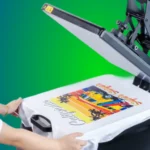Choosing the Best Heat Press for DTF Transfers

Direct to Film (DTF) printing has taken the custom apparel industry by storm. Its versatility, quality, and ability to handle complex, multicolor designs make it a go-to solution for creators of all levels. However, great prints require more than just high-quality film and ink; you need the best heat press for DTF transfers to achieve flawless, durable results.
Whether you’re making custom transfers at home or running a shop with DTF transfers wholesale, your heat press setup can make or break your workflow. This guide breaks down what you should look for in a heat press for DTF transfers, the features that matter most, and how to choose a model that balances performance and price without compromising on results.
Why the Heat Press Matters in DTF Transfers
Your DTF transfer press is the final step that locks the design onto the garment. Without the right machine, even the best-printed dtf transfers can peel, fade, or crack. What you need is a heat press that delivers consistent pressure, reliable temperature control, and accurate heat distribution. These elements ensure proper bonding between the adhesive and fabric, resulting in a long-lasting design that can withstand regular washing and wear.
Many creators assume that all heat press machines perform the same, but that’s far from the truth. Many heat presses lack the stability, control, or surface area required for high-quality heat transfer applications, especially with direct to film materials. From hobbyists printing a few shirts a week to professionals managing bulk orders, investing in the best heat press for your needs is non-negotiable if you want professional-grade results every time.
Key Features to Look For in a Heat Press for DTF
Even Heat Distribution
For DTF transfers to adhere correctly, your press must offer even heat distribution. Uneven heat can lead to partial transfers, cold spots, or patchy finishes. A quality heat press ensures the entire platen surface maintains a steady, uniform temperature, giving you consistent results from corner to corner. Whether you’re working with a standard shirt or a uniquely shaped item, consistent heat distribution is non-negotiable.
Accurate Temperature Control
DTF requires precision. If your press fluctuates even slightly, it can affect the outcome of your heat transfer. Look for heat press machines with digital temperature controls and built-in thermometers. Maintaining accurate temps is crucial when working with direct to film adhesives that need the perfect melt point to bond effectively.
Adjustable Pressure
Too much pressure can damage your transfer or fabric, while too little means the adhesive won’t bond properly. The best heat press for DTF will let you easily dial in the right amount of consistent pressure based on garment thickness and material type. A machine with a responsive adjustment knob or lever will help you achieve the right settings every time.
Timer and Safety Features
Built-in timers allow you to set your press to the exact transfer duration, so you’re not stuck watching the clock. Features like auto-shutoff and alarms protect your projects and give peace of mind during high-output sessions. If you’re running a dtf transfer business, these functions are essential.
Size and Compatibility
Not every job is the same, and neither are heat press machines. Make sure your press can handle your most common print sizes. For large batch dtf transfers, a 16″x20″ press or larger is ideal. Smaller presses work for tight workspaces but might limit your efficiency.
Build Quality and Usability
A sturdy frame, smooth hinge motion, and ergonomic handle make the heat press experience safer and more comfortable. Look for machines with a solid reputation and real-world reviews. Whether you go with a clamshell heat press or swing-away design, build quality plays a major role in longevity and ease of use.
Types of Heat Press Machines for DTF
There are several styles of heat press machines, but the two most commonly used for dtf transfers are clamshell heat press and swing-away presses.
Clamshell heat press machines open vertically and are compact, making them a great fit for tight spaces. They’re popular for their ease of use and fast production flow, especially in fast-paced environments.
Swing-away presses offer more clearance between the heating element and the garment, which is ideal for thicker materials or when you need to line up designs precisely. They’re also safer for beginners since the hot platen swings away completely, minimizing burn risk.
Whichever style you choose, make sure the heat press meets the specific needs of your dtf transfer workflow.
Best Temperature and Pressure Settings for DTF Transfers
Using the correct settings is just as important as owning the best heat press. For most direct to film applications, you’ll want to set your heat press to around 300–320°F with medium to firm consistent pressure. Press the dtf transfer for 15–20 seconds, then let it cool before peeling.
Every manufacturer’s dtf transfers may vary slightly, so always follow their recommended instructions. Adjusting your temperature or pressure slightly might help fine-tune the results for specific garment types or climates.
Recommended Heat Press Models for DTF Printing
Looking for the best heat press for DTF transfers? Here are some solid options worth considering:
- HIX SwingMan 15 or 20 – Trusted, heavy-duty build with even heat distribution and adjustable pressure.
- Hotronix Fusion IQ – A high-end choice with smart tech, ideal for commercial dtf transfer shops.
- Fancierstudio Power Heat Press – A budget-friendly heat press with solid performance for starters.
- VEVOR or Cricut Autopress – Great for home users or hobbyists experimenting with dtf transfers and custom transfers on a small scale.
Each model suits different needs, so choose the one that matches your volume, workspace, and level of experience.
Heat Press Buying Tips: Budget vs. Performance
Not all heat presses are created equal, and price doesn’t always mean quality. Here’s what to keep in mind when choosing your dtf transfer press:
- If you’re just starting out or making custom transfers occasionally, a mid-range model will serve you well.
- If you’re handling dtf transfers wholesale or selling regularly, invest in a durable, commercial-grade heat press machine that can withstand heavy use.
- Consider the warranty, user reviews, and support availability.
- Compare many heat presses side-by-side for features like pressure knobs, timers, and heat distribution consistency.
Balancing cost with capability is the key to finding the right heat press for your needs.
How to Maintain Your Heat Press for Long-Term Use
A well-maintained heat press lasts longer and works better. Wipe down the platen regularly, especially after heat transfer jobs that leave residue. Check for loose bolts, and always monitor the heat distribution with a temperature gun to catch inconsistencies early.
Avoid slamming or forcing the platen closed, and keep the machine covered when not in use. Regularly inspect cords and connections, especially on high-use heat press machines in commercial settings. A little maintenance goes a long way in preserving the precision and performance of your dtf transfer press.
Final Thoughts
Choosing the best heat press for DTF transfers isn’t just about price tags, it’s about what delivers results, fits your setup, and works hard with you. Whether you’re building out a professional print shop or customizing tees from your craft room, the heat press you choose will define the quality of your direct to film prints.
With the right size, temperature range, pressure adjustability, and build quality, your heat press becomes a reliable tool for creating standout dtf transfers time and time again. Explore, compare, and invest wisely and don’t forget to check out Southern Style Graphics for trusted supplies, DTF transfers wholesale, and UV DTF transfer solutions to take your printing business even further.



